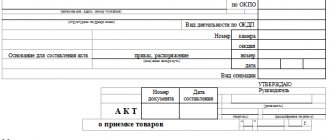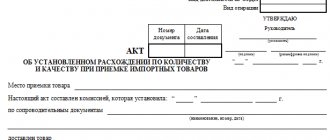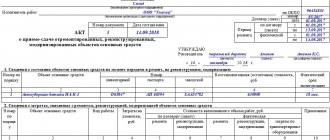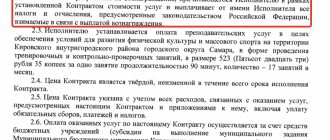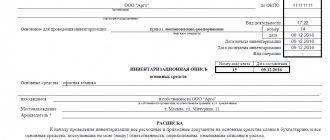Why is it necessary?
This is a two-sided (at least) document that is drawn up for the purpose of transferring goods from one person to another. There are many options for who draws up the document:
- two employees of a budget organization;
- institution and its employee;
- two organizations that have entered into an agreement to purchase or transfer for storage.
For all these business transactions, you will need to fill out a transfer and acceptance certificate.
Form for acceptance and transfer of goods
Organizations usually have ready-made forms for such acts, created by developing them independently, so all that remains is to fill them out carefully in order to avoid unpleasant moments later.
For information on the form of the document used for acceptance of goods by the buyer, read the article “Unified Form TORG-1 - Certificate of Acceptance of Goods”.
We will talk in more detail about the details that must be present in the acceptance certificate of goods.
How to register and how long to store
It is more correct to transfer the purchased goods using the unified document TORG-12 - a unified form of consignment note. But if it is not possible to draw it up, and the terms of the contract allow or even insist on drawing up an act of transfer of material assets, then remember that it is the primary accounting document transferred to the accounting service. This means that it is necessary to indicate mandatory details (Article 9 of the Federal Law of December 6, 2011 N 402-FZ). It must also contain the following information:
- name and date of compilation;
- name of the organization and employee who compiles;
- content of the fact of economic life (what we convey, on what basis);
- units of measurement of transferred items, their quantity, price;
- job title, signature and transcript of the signature of the person receiving the goods and materials.
It is drawn up in two copies, and then a copy is given to each of the parties to the transaction. Like other primary accounting documents, it is stored for five years after the reporting year.
IMPORTANT!
Remember that such an act does not replace the contract, but is drawn up on its basis!
What to include in the goods acceptance certificate
It was mentioned above that the goods acceptance certificate must contain some mandatory details, in particular:
- Name (act of acceptance and transfer of goods), date and place of its preparation.
- The preamble must indicate within the framework of the execution of which contract the act of acceptance and transfer of goods is drawn up, as well as the names of its parties. If the act is drawn up between legal entities, then their names, full names of representatives are indicated and references are made to the document on the basis of which the representatives participate in the preparation and signing of the act (if this is a manager, then his powers are enshrined in the statutory documents, and if the representative is an employee of the organization, then his powers can be specifically reflected in the same documents, or a power of attorney is issued in his name, data that must be reflected in the act). If the parties to the agreement are individuals, then the act reflects their names, passport details, and place of registration.
- Full description of the transferred goods (article, brand, model, quantity, unit cost and total cost of the goods).
- Information about identified defects or the absence thereof, about violation of the terms of delivery of the goods (it should be noted that an indication of the absence of identified defects in the goods does not deprive the recipient of the opportunity to make quality claims after acceptance within the time limits established by law or contract).
- The text of the acceptance certificate for the transfer of goods is completed with personal signatures of the participants in the acceptance and transfer procedure, as well as seals (if any).
the act can be free by clicking on the picture below:
About the form that must be drawn up if, at the time of acceptance of the goods, discrepancies are identified in its quantity and quality with the data specified in the shipping documents, read the material “Unified Form Torg-2 - Form and Sample”.
What to do if you find defects in the product after signing the acceptance certificate? Study the answer to this question in Consultant Plus. If you do not have access to the K+ system, get a trial online access for free.
Commission act for acceptance of materials
If the party receiving the goods believes that the delivered goods do not comply with the terms of the contract, or the papers transferred with goods and materials differ in quality or quantity from the delivery, it draws up the paper in form 0504220. It is signed by the commission for the receipt and disposal of the institution’s assets in the presence of the financially responsible person and a representative of the organization - supplier or other disinterested representative.
How to draw up a TORG-15 act on the write-off of goods
Sample documentation in the TORG-15 form is used in situations where damage, damage or scrap of any material assets is detected. TORG-15 refers to primary accounting documentation, but the use of this particular form has been considered optional since 2013. Therefore, the company can file damage to inventory items in free form or approve its own sample. However, in practice, to facilitate document flow processes, f. TORG-15.
Fact! To draw up TORG-15, a commission approved by the organization is involved. It includes at least 3 people: a representative of the administration, a financially responsible person and any third representative. Often this may be a health inspector.
As a result of drawing up the paper, the damage caused is assessed, and the person responsible for damage or scrap of valuables is assessed. The amount of damage is written off from him.
The form consists of two sheets, compiled f. TORG-15 as follows:
- at the top there is a block of information about the organization and structural unit;
- in the upper right corner - codes are given, the form is approved by the manager;
- after the name in the top line the reason for drawing up the act is indicated;
- in the main table, inventory items, their characteristics (article, grade, etc.), price before and after evaluation, nature of defects are written down;
- After the table, the commission indicates the reason for the damage and the person responsible.
On the reverse side, the commission writes information about the posting of scrap and scrap, as well as the destruction of what can no longer be used. The act is signed by all members of the commission, it is established who will pay for the damage.
How to draw up for the reception and transfer of material assets
The next option is the transfer of property within the organization: from one financially responsible person (hereinafter referred to as the MOL) to another or from the organization to an employee. In this case, it is necessary to draw up a document. This can be done in any form with the obligatory indication of the date of the procedure, the name of the items of transfer, their quantity and the persons to whom the values are transferred. If the transfer occurs from one MOL to another, new one, then an agreement on individual (or collective) financial responsibility must be signed with the second one. One copy is at the MOL, the second is in the accounting department.
The transfer of material assets for temporary storage should be formalized with paper confirming that the inventory assets have been transferred for storage. For this purpose, a unified form MX-1 has been created (OKUD code 0335001), which is not mandatory for use, but is very convenient to use, therefore it is widely used in budgetary organizations.
Application of the document
Let's take a closer look at the cases when this document is drawn up:
- discrepancy in quantity and quality of material assets;
- receipt of goods without documents;
- transfer of material assets for safekeeping;
- transfer of assets under a commission agreement;
- transfer of values within the organization between structural divisions or financially responsible persons;
- transfer of valuables for temporary use (for several hours or days).
The following certificate of delivery and acceptance of goods can be used simultaneously with the MX-1 form of acceptance and transfer of inventory items for storage.
Form of transfer act MX-1
The transfer of cases when changing responsible persons is formalized by an act of acceptance and transfer of cases, but in certain situations the given example of an act of acceptance and transfer of goods and materials is allowed to be used: for example, for the transfer of keys to a safe, valuable equipment, etc.
Certificate of acceptance and transfer of property between financially responsible persons
| I APPROVED CEO [name of company] [FULL NAME. director] Certificate of acceptance and transfer of property No.___ [place of transmission] | [day month Year] |
In connection with the change of the financially responsible person [position], according to the results of the inventory carried out on the basis of the manager’s order No. ___ dated [day, month, year], the person being relieved of his position [position, full name] passed, and the person taking up [position, full name] in the presence of members of the commission accepted the following property:
| № | Name | Inventory No. | Characteristic | Quantity, pcs. |
- The valuables are fully inspected and accepted by the financially responsible person.
- No discrepancies in quality and quantity were identified.
- The parties have no mutual claims or comments.
- This Act is drawn up in two copies, one for each of the Parties.
- Signatures of the parties:
| The property was rented out | [FULL NAME.] |
| Accepted the property | [FULL NAME.] |
| Chairman of the commission: | [position, full name] |
| Members of the commission: | [position, full name] |
| [position, full name] | |
| [position, full name] |
In what situations is it necessary to draw up an act?
Practice shows that the need to draw up an act of transfer of material assets arises in the following situations:
- if one party has claims against the other regarding the quantity of products, composition, quality characteristics (for example, defective products were discovered);
- products are sent for safekeeping or temporary use;
- the parties work under a commission agreement;
- there is a movement of inventory items between divisions of one company.
Also see "".
Approval by the company of a sample goods acceptance certificate is mandatory if high-tech products are transferred - machines, mechanisms, etc. This is due to the need to check the performance of such products and their external inspection.
When transferring inventory items for temporary storage, the following is recorded in the document:
- composition and current state of values;
- conditions for their further stay;
- FULL NAME. specialist who is financially responsible for them.
Also see “Full Individual Liability Agreement”.
Why is the act needed?
The act of acceptance and transfer of goods is a document confirming the execution of a previously concluded agreement and endowed with legal force, together with the main agreement: the act is its important addition, on the basis of which a certain trade transaction is carried out.
By all rules, a drawn up and signed act is the most important document that helps to avoid conflicts (related to obligations to compensate for losses, the need to eliminate identified shortcomings and defects in goods, etc.), as well as to fairly resolve disputes that arise between counterparties: seller and buyer, supplier and recipient of the goods, etc.
Acceptance certificates for quality and quantity
It is recommended to prepare an acceptance certificate for quality and quantity for each supply contract. In the future, the paper will become evidence in court if the recipient of the goods has claims against the supplier.
There is no single sample document, so you can approve your own sample or draw up an act in free form each time, depending on the situation.
Important! The paper is drawn up and signed by both parties to the transaction. A unilateral order is not considered legal.
The act states:
- information about the participants (recipient and supplier);
- information about the place of acceptance;
- start and end time of acceptance;
- information about packaging, quality, completeness and quantity of goods;
- complete address information about both parties;
- indication of information about accompanying documents of goods (waybills, invoices);
- found deviations from documents, the presence of defects and defects.
The act is signed by both parties.
